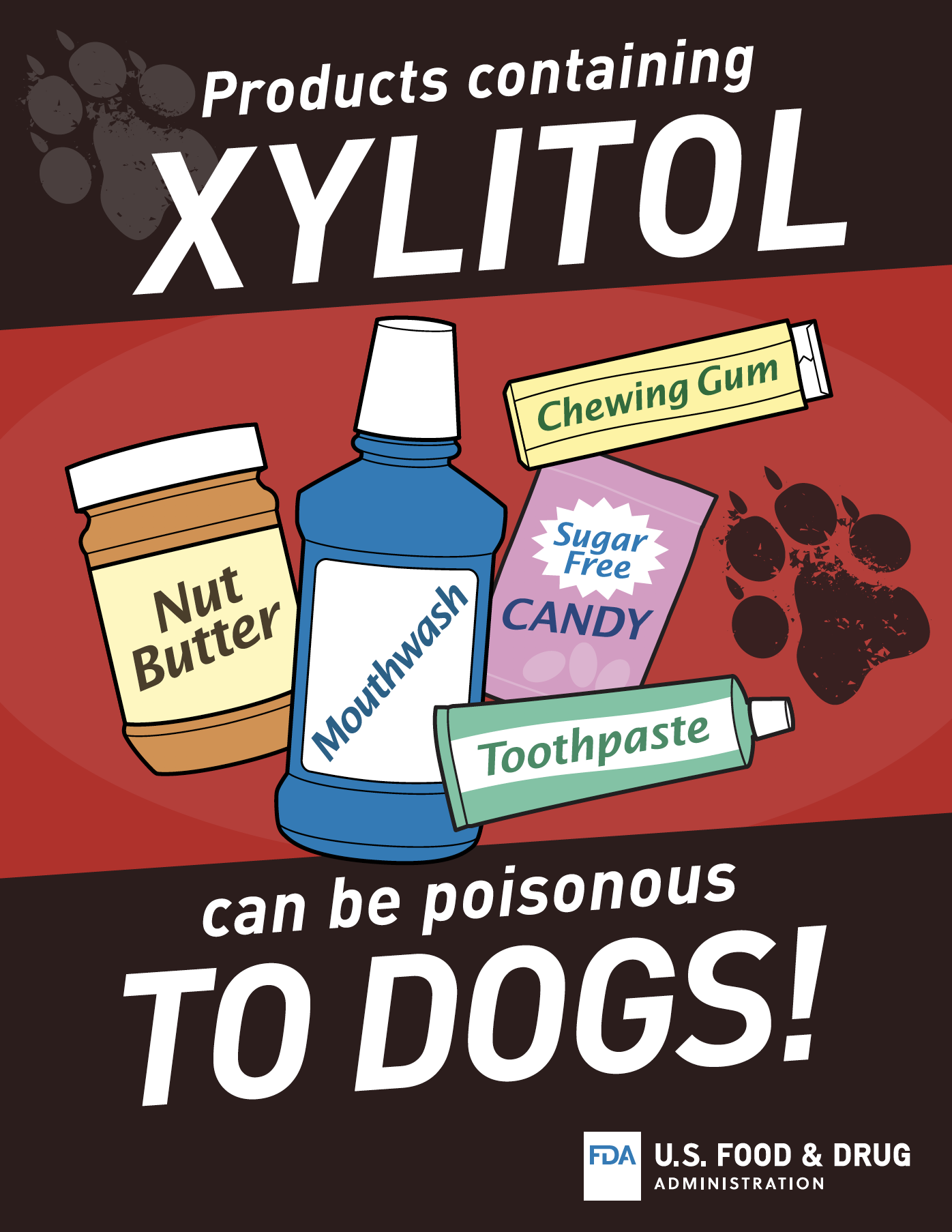
Xylitol poisoning in pets is on the rise. Anyone with a dog should be aware of xylitol and its potential to do harm.
In this article, we will discuss:
- What xylitol is and the common products that contain it
- Why xylitol is dangerous to dogs
- The signs of xylitol toxicity in dogs
- The action to take
- Prevention
At the beginning of the century, only a few cases of xylitol toxicity in pets had been reported. These days, animal poison control centers receive thousands of calls across North America about accidental xylitol poisoning in pets, with many more going unreported.
Xylitol Is Dangerous to Dogs: The Killer in Your Kitchen Cabinet
Back in the 19th century, when people wanted to get rid of a rat infestation they went to the chemist shop and right off the shelf bought arsenic or cyanide.
In the 21st century, the thought of buying a deadly poison with your groceries is laughable. And yet lots of regular, everyday products contain xylitol, which is potentially toxic to pets.
What Is Xylitol?
Long story short, xylitol is an artificial sweetener.
It’s popular in many human grocery products because it gives a sweet taste but without the calories.
For those of a technical nature, it’s manufactured from xylose, which is present in plant tissues, and is actually a crystalline alcohol.
Common Products Containing Xylitol
Xylitol is a natural sweetener found in sugar-free gum (including nicotine gum), mints, candy, baked products and beverages.
And here’s the rub. While you may be clued up to look for xylitol in cookies, it can be a not-so-obvious ingredient in some pharmaceutical formulations, oral rinses, toothpaste and chewable sugar-free vitamins.
All of which means you should always read the full ingredient lists, before anything designed for humans passes your pet’s lips.
Be alert for anything labeled “sugar free.” This is a red flag, because while other artificial sweeteners are available, xylitol is very popular.
If you suspect your pet has eaten xylitol, how soon should you go to the vet?
Right away. When it comes to any type of poisoning, the sooner you identify the poison and treat it, the better the outcome. Seek immediate veterinary attention and bring your pet to your family vet or the emergency clinic as soon as possible. Time is of the essence.
Why Is Xylitol Dangerous?
But if people can eat xylitol, then why not dogs?
Xylitol is on the list of foods that are fine for people but potentially dangerous to dogs. Other products on this list include:
The take-home message being just because it’s safe for people doesn’t mean it’s safe for the dog. In the particular case of xylitol, it can have short-term and long-term consequences.
In the short term, it does weird things to the pet’s blood sugar levels, triggering the equivalent of a diabetic coma. In the long term, it can cause liver damage and failure.
Was YOUR Pet Food Recalled?
Check Now: Blue Buffalo • Science Diet • Purina • Wellness • 4health • Canine Carry Outs • Friskies • Taste of the Wild • See 200+ more brands…

Short-Term Consequences
Xylitol messes with the pet’s blood sugar levels. It does this by causing a rapid and massive release of natural insulin in the body.
As anyone with diabetes knows, too much insulin means the sugar gets driven out of the bloodstream. This deprives the organs and body tissue of power — much like unplugging a car battery so the vehicle can’t run. Only for the pet this means loss of consciousness and coma.
And xylitol acts quick — really quick. Some pets show signs (depending on the amount eaten) within 10–15 minutes. So you need to get help fast.
Long-Term Consequences
Sadly, if a dog has a large dose of xylitol, there’s a possibility of liver complications down the line.
With higher doses, xylitol toxicity can also cause severe, irreversible liver damage.
Clinical signs of liver failure may not be apparent for 1–2 days, and include vomiting, black tarry stool, coma, increased liver enzymes, jaundice, clotting problems, coma and even death.

Signs of Xylitol Poisoning in Dogs
If a pet eats a product containing xylitol, don’t wait for the symptoms to develop.
Without exception, call the vet immediately and seek emergency help.
The signs described below are for information purposes only and no one should wait to see if they develop … because missing the window of opportunity before the pet becomes sick can have serious consequences.
- Staggering and walking as if drunk
- Weakness
- Vomiting
- A racing heart
- Extreme sleepiness
- Loss of consciousness
- Seizures
- Coma and death
Liver complications may develop after a day or so, and signs include:
- Black tarry feces
- Bleeding and clotting problems
The severity of symptoms depends on the amount of xylitol swallowed and the weight of the dog. Here are some rough guidelines:
- When as little as 50 mg per pound of dog weight of xylitol is consumed, low blood sugar can occur.
- But if 250 mg/lb. is swallowed, severe liver damage or even death can occur.
First-Response Action for Xylitol Toxicity in Pets
Xylitol can result in severe poisoning in dogs, and possibly in cats, in as little as 15–30 minutes.
To labor the point (because it’s so important), if your pet eats something that contains xylitol, drop everything and phone the vet immediately. They will guide you as to what to do next.
However:
- DO NOT make the pet sick (unless first instructed to do so by the vet).
Making the pet vomit if they are a little sleepy can have serious consequences, so this is definitely a case of “Don’t try this at home.”
- DO give the pet something sugary to eat.
If you suspect or know your pet ate a product containing xylitol, the first thing is to give pet food or a source of sugar (Karo syrup or pancake syrup). This may buy a short amount of time so that you can get to the vet.

What Will the Vet Do?
- Early on (before signs occur), vomiting may be induced by your veterinarian, provided your pet isn’t showing any symptoms. This will help decrease absorption of xylitol and further poisoning.
- The vet will then monitor the patient closely, including taking regular blood glucose readings. This helps them spot if the levels go down and take counter-actions to support the pet.
But, if the pet is already showing signs of low blood glucose, then forcing them to vomit could do more harm than good. So what’s to be done?
Is there a xylitol antidote?
There is no xylitol “antidote” as such, but what the vet will do is artificially support blood glucose levels by giving glucose intravenously. The clinician may also need to correct swings in the body’s electrolyte levels, which can also be potentially dangerous.
Once you are at your veterinarian’s clinic, blood work should be performed right away to see how low the blood sugar is, and to evaluate the liver enzymes. Blood work may need to be repeated several times a day to monitor the status of the pet.
Treatment will depend on the timing of ingestion, the time to decontamination, the amount of xylitol ingested by the dog or cat, the clinical signs seen, and the results of the blood work.
All in all, treatment requires careful monitoring of the patient and proactive reactions by the clinician to keep the patient on an even keel.
With severe cases of xylitol poisoning in pets, liver failure and clotting problems can occur. In these cases, the use of plasma transfusions, vitamin K and other medications may be necessary.
If the pet survives the initial insult but has a “liver toxic dose,” the use of liver protectants such as S-Adenosyl methionine (SAMe) may be necessary (typically for 1–2 weeks). These protect the damaged liver and encourage it to repair.
What Are the Consequences of Xylitol Toxicity?
What is the outcome?
The outlook is related to the amount of xylitol eaten, the size of the dog and the timing of treatment.
- With mild signs (e.g., low blood sugar) and prompt treatment, the outcome is typically good.
- With more severe signs (e.g., severe liver damage, clotting abnormalities and jaundice) or delayed treatment, then collapse, coma and death are a real possibility.
How can you prevent xylitol toxicity?
“Educate yourself about where xylitol is found,” says Dr. Justine Lee, DVM, DACVECC, a board-certified emergency critical care veterinary specialist and associate director of veterinary services at Pet Poison Helpline.
“Read the labels of any sugar-free products in your kitchen, your bathroom and your purse. And either ban these products from your house and your purse or secure them very carefully to prevent your pets from ever getting into them,” she advises.
What about other sweeteners?
“To our knowledge, other sweeteners like saccharin, aspartame, malitol, sorbitol and sucralose are not toxic in pets, as long as they are not ingested in significant amounts.
If you’re going to chew gum and have pets, make sure xylitol isn’t found in your gum or baked goods.
Additional Resources
- To learn more about xylitol and which products it can be found in, visit petpoisonhelpline.com/poison/xylitol/.
- If you suspect your pet may have ingested anything poisonous, contact your veterinarian or an animal poison control by calling 855-764-7661.
Help Us Raise Awareness
Simply click the image below and to get a poster-sized version that you can print out and post. Or share this article with your friends on social media.

References
- “Paws Off Xylitol; It’s Dangerous for Dogs.” U.S. Food and Drug Administration. July 9, 2019. https://www.fda.gov/consumers/consumer-updates/paws-xylitol-its-dangerous-dogs.
- Brutlag, Ahna, DVM, DABT, DABVT. “Xylitol Toxicity in Dogs.” VCA Animal Hospitals. 2015. https://vcahospitals.com/know-your-pet/xylitol-toxicity-in-dogs.
- Sollid, Kris, RD. “What Is Xylitol?” International Food Information Council Foundation. Jan. 3, 2019. https://foodinsight.org/what-is-xylitol/.
- Gunnars, Kris. “Xylitol: Everything You Need to Know.” Healthline. Oct. 4, 2018. https://www.healthline.com/nutrition/xylitol-101.
- Schmid, Renee D., DVM. “Xylitol: It’s Everywhere!” Pet Poison Helpline. https://www.petpoisonhelpline.com/uncategorized/xylitol-its-everywhere/.
- Gilpatrick, John. “6 Dangerous (and Surprising) Items That Contain Xylitol.” PetMD. https://www.petmd.com/dog/emergency/poisoning-toxicity/6-dangerous-and-surprising-items-contain-xylitol.
 This pet health content was written by a veterinarian, Dr. Pippa Elliott, BVMS, MRCVS, with contributions from Dr. Phil Zeltzman, DVM, DACVS, CVJ. This article was originally published in 2012 and is regularly updated. It was reviewed for accuracy by Dr. Elliott and was last updated March 25, 2020.
This pet health content was written by a veterinarian, Dr. Pippa Elliott, BVMS, MRCVS, with contributions from Dr. Phil Zeltzman, DVM, DACVS, CVJ. This article was originally published in 2012 and is regularly updated. It was reviewed for accuracy by Dr. Elliott and was last updated March 25, 2020. 

